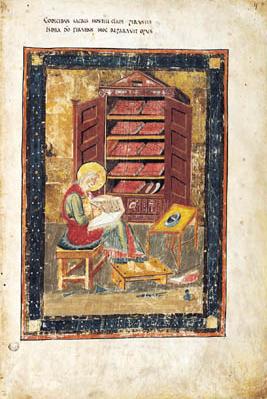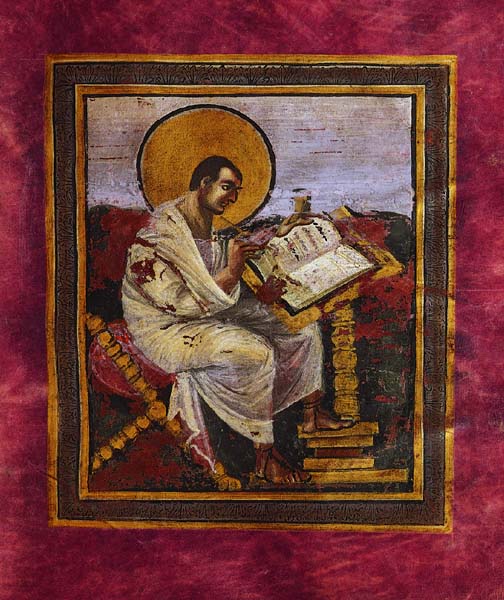
|
|
Title: Purse cover, form the Sutton Hoo ship burial in Suffolk, England Artist: unknown Date: 7th century Medium: gold, glass, and cloisonne garnets Period: Early Medieval Historical Importance: Highlights many hallmarks of early medieval art, including geometric design and patterns integrated with abstract animal forms (such as the eagles, ducks, and beasts here), intricate metalwork, and the cloisonne technique, whereby small metal strips would be formed to outline designs that were then filled in with semiprecious stones. |

|
|
Title: ANimal-head post, from the Viking ship burial, Oseburg, Norway Artist: unknown Date: 9th century Medium: carved wood Period: Early Medieval Historical Importance: This animal-head post features an interlace pattern composed of tightly interwoven animals carved into the roaring animal's head, making the object a strong example of two important motifs in early medieval art in western Europe: the animal and the interlace pattern. |

|
|
Title: Saint Matthew, folio 25 verso of the Lindisfarne Gospels Artist: unknown Date: early 8th century Medium: tempera on vellum Period: Early Medieval Historical Importance: The imagery for this author's portrait is modeled on an Italian Gospel book, as the Saint Matthew figure is sitting and writing in a similar style to those ealrier works. He is also seated on an angled bench and placed in an interior space, as evidenced by the curtain. However, this older style is married with the new early medieval style, as the volume, perspective, and shading of classical works are ignored in favor of sharp lines and flat colors. |

|
|
Title: Chi-rho-iota page, from the Book of Kells Artist: unknown Date: early 9th century Medium: tempera on vellum Period: Early Medieval Historical Importance: you know this ish, way obvious. most bootyful ever, way intricate, etc etc |

|
|
Title: Equestrian portrait of Charlemagne Artist: unknown Date: early 9th century Medium: bronze statue Period: Early Medieval Historical Importance: This representation of Charlemagne on a horse evokes the classical statuettes of Marcus Aurelius, a similarity that perfectly parallels Charlemagne's aims to make his empire as glorious as that of ancient Rome. |

|
|
Title: Saint Matthew, of the Coronation Gospels Artist: unknown Date: early 9th century Medium: ink and tempera on vellum Period: Early Medieval Historical Importance: In contrast to the Lindisfarne Gospel illustration of Saint Matthew, this representation builds directly on classical techniques, using light and shading to create volume. This emphasizes the reverence Charlmagne held for ancient Rome, and his court's desire to evoke the classical. |

|
|
Title: Saint Matthew, of the Ebbo Gospels Artist: unknown Date: 9th century Medium: ink and tempera on vellum Period: Early Medieval Historical Importance: Like the Lindisfarne Gospel, this representation of Matthew takes a classical image and translates it into the new style, in this case Carolingian. The artist uses hard, frenzied lines and bright colors to create movement and to give the sense that Matthew is writing frantically. |

|
|
Title: Doors with relief panels, Saint Michael's at Hildesheim Artist: commissioned by Bishop Bernward Date: 11th century Medium: bronze Period: Early Medieval Historical Importance: By depicting the Old Testament story of Adam and Eve alongside the Gospel story of Christ, the doors seek to draw a parallel between Adam and Eve's transgression and Christ's crucifixion, as well as his resurrection (new beginning) and the creation of man.These specific comparisons are made in the order the specific door panels are juxtaposed. |

|
|
Title: Column with reliefs illustrating the life of Christ, Saint Michael's at Hildesheim Artist: commissioned by Bishop Bernward Date: 11th century Medium: bronze Period: Early Medieval Historical Importance: This column's depiction of the life of Christ is undoubtably modeled on the Column of Trajan. This not only suggests victory and triumph in Christ, but also helps support the Ottonian emerpor's claims that they were to be the heirs to Charlemagne's renovatio imperii Romani. |

|
|
Title: Crucifix, Cologne Cathedral Artist: commissioned by Archbishop Gero Date: 10th century Medium: carved and painted wood Period: Early Medieval Historical Importance: This crucifix shows a completely different Christ from that depicted in Early Christian work. He is experiencing very human suffering here, as shown in his weighted body, stretched muscles, intense bleeding and contorted facial expression. |